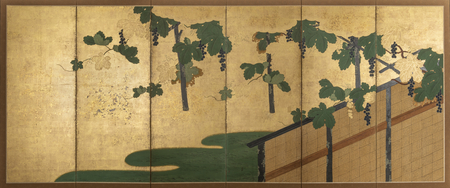Product Description
7750 A six-fold paper screen painted in ink and colour on a gold ground with grape vines hanging from a pergola and woven fence amongst golden clouds, the details in gin-sunago (cut silver leaf) and moriage (raised design)
The metal mounts are decorated with cloisonné enamel a special detail rarely seen on screen mounts.
Japan 17th/18th century Edo period
Dimensions: H. 154.5 cm x W. 363 cm (60¾” x 143″)
Grapes represent the autumn season and have been regarded as an auspicious symbol of fertility and prosperity since ancient times. Also the Japanese word of grape ‘budō’ is the same word for martial arts. Often paired with squirrels (‘risu’ in Japanese meaning, to follow discipline), the subject was a favourite of the samurai class.
Designs incorporating grape vines have been used for ceramic and lacquer works as well as paintings from early times, and screens depicting this subject matter seem to have been particularly popular in the early Edo period however only a few examples are known today.
These known examples depicting grape vines are rendered in a similar manner using gold leaf and moriage (raised design):
For a pair of screens from the Kano School housed in the Tokyo Fuji Art Museum (17th century, Momoyama period), see National Museum of Scotland ed., Behind Golden Screens: Treasures from the Tokyo Fuji Art Museum, exhibition catalogue, (Edinburgh, 1991), covers and p. 26-27, no.3.
For a pair in the Gardner collection (17th century, accession no. P14e3), visit:
https://www.gardnermuseum.org/experience/collection/11647#gref
For another pair (c. 1600), see Wakisaka Jun et. al. eds., Flower and Bird Paintings of Japan, Vol. 4, Late Momoyama Period, (Tokyo, 1982), no. 34-35.
There are another comparable pair of 17th-century screens housed in the Okura Museum of Art, Tokyo, and there are a pair of sugido (cedar wood doors) with the same subject housed in the Nagoya Castle, Aichi prefecture.












